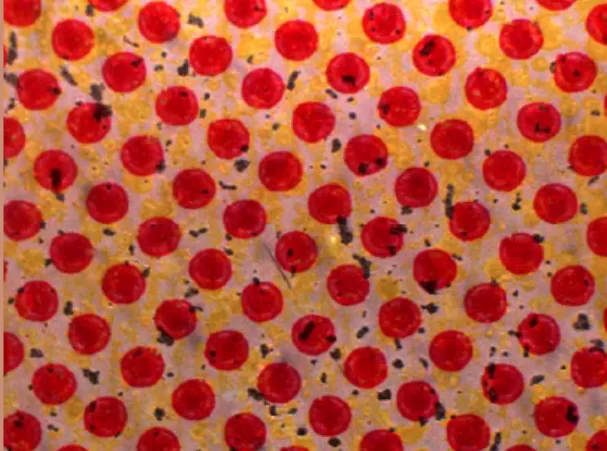This article is part of the FLEXO FLAW FIXING series
In the complex world of flexo printing, producing crisp, clear images is paramount. But sometimes a persistent problem arises that can derail even the most meticulous print runs: deformed screen dots. This anomaly can turn what should be pinpoint precision into a blurry mess, drastically undermining print quality. In this guide we look at the causes, diagnosis and solutions to screen dot deformation in flexo printing, and offer practical advice to ensure your flexo printing remains top notch.
Causes and Remedies for Screen Dot Deformation in Flexo Printing
Identifying the culprit behind deformed screen dots is the first step to solving the problem. Often the dilemma lies not in the equipment but in the pre-press stage, so a thorough check of the artwork is crucial. If the artwork is found to be faultless, the next focus is on the screen itself, the condition of the flexo plate and the adhesive tape that holds it in place. These components must work in harmony to produce the desired image clarity.
Anilox Roll Issues
- Cause: Often described as the heartbeat of flexo printing, the anilox roll’s cells are responsible for transferring precise amounts of ink to the plates. If these cells are too shallow, they will transfer too little ink; if they are too deep, they will transfer too much.
- Remedy: The solution is to either refurbish or replace the anilox roll to ensure it is delivering the right amount of ink for the job. In addition, monitoring the condition of the roll between runs can predict potential problems.
Misaligned Printing Plates
- Cause: Precision is the cornerstone of flexo printing, and even the slightest misalignment of printing plates can lead to significant quality problems. Correcting this requires a multi-step approach.
- Remedy: The first step is to carefully realign the plates, adjusting them until test prints show no signs of distortion. Ongoing inspection and maintenance of the plate mounting equipment will ensure continued accurate alignment and prevent future problems.
Web Tension Issues
- Cause: Inconsistent web tension can wreak havoc on dot formation and distort the image as it moves through the press.
- Remedy: Solving this problem may mean upgrading tension control systems to more sophisticated, automated options that can respond to real-time variations and ensure consistent tension throughout the run.
Speed Synchronisation
- Cause: Coordination between the plate and the impression cylinders must be perfect.
- Remedy: Technicians should regularly check and adjust the gear and servo drives responsible for maintaining speed between the units to prevent slippage and ensure consistent dot shape. This may include the use of updated software that controls the printing process more precisely.
Inappropriate Relief Depths
- Cause: Using a plate with an inappropriate relief depth is an open invitation to distorted dots.
- Remedy: Use a plate that’s appropriate for the substrate and ink type you’re working with. Consultation with plate and material suppliers can help you determine the most effective relief depth.
Pressure Variations
- Cause: Incorrect pressure applies inappropriate force to the screen dots, causing them to deform in the output.
- Remedy: Finding the sweet spot for pressure settings can take some trial and error. But it’s time well spent, as the right pressure will ensure that the dots on the screen do not spread or distort during application. If reducing the pressure doesn’t solve the problem, consider consulting the press manufacturer or a specialist – it may indicate a need to recalibrate or service the printing mechanisms.
Variations in Plate or Tape Thickness
- Cause: Greater thickness applies an augmented force to the screen dots, causing them to deform in the output.
- Remedy: Confirm the dimensions of your plates and tape before you start. Ensuring that the thickness of the tape and plate are within the required specifications for the job in question avoids the risk of uneven printing and the distorted dots that can result. Quality checks on each new batch of material can prevent this problem before it affects print quality.
Conclusion and Reminder
Achieving the perfect print is a delicate balance that requires attention to a myriad of details. Screen dot deformation can be an annoying problem in flexo printing, but with the right approach they are entirely manageable. Regular diagnostic checks, precise adjustments and a thorough understanding of how your equipment interacts can eliminate many of these problems.
Build routine maintenance into your workflow. Make sure your screens are properly tensioned, thinner inks are used when necessary and print heads are spotlessly clean. These seemingly small adjustments can make a big difference to the quality of your prints.
Remember, preventing deformed screen dots not only saves your current project, but also maintains the integrity of your printing practice. By fostering an environment where precision is paramount, you’ll continue to produce prints that embody clarity and quality.


![[Flexo Flaw Fixing] Screen Dot Deformation](https://flexopedia.net/wp-content/uploads/2022/05/039_Deformed_Dots.png)
![[Flexo Flaw Fixing] Skip-Out Effect](https://flexopedia.net/wp-content/uploads/2022/07/070_Skip_Out.png)

![[Flexo Flaw Fixing] Low Ink Adhesion](https://flexopedia.net/wp-content/uploads/2022/07/Adhesion_Tape_Test.png)
![[Flexo Flaw Fixing] Ink Spitting](https://flexopedia.net/wp-content/uploads/2022/11/068_Dirty_Print-jpeg.webp)